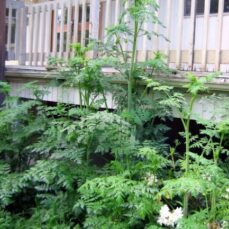
Photo credit: Jeff Stachler, The Ohio State University, Bugwood.org
Management Category
Squamish
Whistler
Pemberton
Vectors of Spread
Synonyms
- Hemlock
- Deadly hemlock
- Poison parsley
- Poison fool’s parsley
ID Characteristics
General: Poison hemlock is a biennial plant in the Apiaceae (carrot or parsley) family that forms a short leafy rosette in the first year, and develops a tall hollow stem and several clusters of flowers the following season.
Flowers: Small and white, growing into umbrella-shaped clusters (called umbels) that are about 7 – 8 cm across, starting in early summer.
Stems: Hollow, thick, hairless and ridged, with purple spots. Stems are highly branched and 0.5 – 3 m tall.
Leaves: Triangular, shiny green, fern-like (finely divided). Poison Hemlock leaves emit an unpleasant, parsnip-like odour when crushed.
Roots: Long, thick, pale yellow or white taproot.
Seeds: Small (about 2 mm long), ridged and flattened, with two seeds borne together.
Similar Species
You can refer to the Fraser Valley Invasive Species Society’s guide to help you tell Poison Hemlock apart from other plants of the same family

Photo credit: Catherine Herm, Ohio State University, bugwood.org
Invasive:
Queen ann’s lace, or wild carrot (Daucus carota) is sometimes mistaken for poison hemlock, but this plant has one densely-packed, umbrella-shaped flower cluster on a narrow, hairy stem. Wild carrot also flowers later in the summer.

Photo credit: Williammehlhorn
Native:
Water hemlock (Cicuta maculata) is also similar to poison hemlock, but the leaf veins end in notches between the teeth of the leaflets, whereas in poison hemlock they end at the tips of the teeth.
Habitat and Origin
Poison hemlock originates from Europe and North Africa. Poison hemlock was introduced in North America as a garden ornamental.
Poison hemlock thrives in moist soils at sunny disturbed sites, though it can also withstand dry soils. It is typically found on roadsides, field borders, stream banks, riparian woodlands and floodplains.
How it Spreads
Poison hemlock spreads by seed. One plant can produce over 1,000 seeds, which remain viable in the soil for 3 – 5 years. Poison hemlock is a biennial plant: it forms a short leafy rosette the first year, and develops a tall hollow stem and several clusters of flowers the following season.
Seeds are spread on machinery, clothing, or in transported soil. To a lesser extent, they can also be dispersed by water and wind.
Impacts
Health:
- POISONOUS: Every part of the plant, especially the leaves and fruit, contain a volatile, oily compound that is so poisonous that a few drops can prove fatal to small animals.
- Human deaths have occurred from harvesting and consuming the roots, having been mistaken for wild carrots or parsnips.
Ecological:
- Reduces biodiversity; acts as a pioneer species, quickly colonizing disturbed sites and displacing native species.
Economic:
- Toxicity affects the value of croplands.
Prevent the Spread
Poison hemlock is NOT currently found throughout the Sea to Sky Region, so PREVENTION is key:
- Regularly monitor properties for weed infestations.
- Remove plant material from equipment, vehicles or clothing used in infested areas and wash equipment and vehicles at designated cleaning sites before leaving infested areas.
- Ensure soil and gravel are uncontaminated before transport.
- Minimize soil disturbances (e.g., use grazing plants that prevent soil exposure from overgrazing), and use seed mixes with dense, early colonization (e.g., alfalfa or barley) to re-vegetate exposed soil and resist invasion.
- Ensure invasive plants (particularly flowering heads or root fragments) are bagged or covered to prevent spread during transport to designated disposal sites (e.g., landfill). Do NOT compost.
Control
Mechanical control:
Mowing or hand-pulling before the seed set will eventually deplete the seed bank. Exercise caution when working near poison hemlock. Minimize exposure by wearing gloves and taking frequent breaks when pulling or mowing the plant.
Chemical control:
Poison hemlock tends to grow in wet areas, so the use of herbicides is restricted. Where possible, foliar applications at the rosette stage of dicamba, 2,4-D and glyphosate are effective. Herbicide treatment may need to be repeated for several years until the seed bank is depleted.
We recommend that any herbicide application is carried out by a person holding a valid BC Pesticide Applicator Certificate. Before selecting and applying herbicides, you must review and follow herbicide labels and application rates; municipal, regional, provincial and federal laws and regulations; species-specific treatment recommendations, and site-specific goals and objectives.
Biological control:
There are no biocontrol agents currently available in BC. However, Agonopterix alstroemeriana (moth) is used in several US states as it feeds exclusively on poison hemlock.
B.C. Distribution
Poison Hemlock Factsheet
Having trouble viewing the factsheet? Don’t worry, all the information is included on this page. You can also contact us with any questions.
Additional Resources
References
- Capital Regional District, Poison Hemlock Species Alert Sheet
- Coastal Invasive Species Committee, Poison Hemlock
- Creston Valley, Invasive Plant Species: Poison Hemlock
- CTV News, Invasive Poison Hemlock A Growing Concern on Vancouver Island
- District of Saanich, Poison Hemlock Invasive Plant Alert
- Electronic Atlas of the Flora of BC, Conium maculatum
- Fraser Valley Invasive Species Society, Look-alike Guides
- Fraser Valley Invasive Species Society, Poison Hemlock
- Government of BC, “Poison Hemlock” in A Guide to Weeds in British Columbia
- Invasive Plant Atlas of the United States
- King County Noxious Weeds Program, Poison Hemlock Identification and Control
- Lillooet Regional Invasive Species Society, Poison Hemlock (Conium maculatum)
- Southern Indiana Cooperative Weed Management Area, Poison Hemlock
- USDA Forest Service, Weed of the Week: Poison Hemlock


















